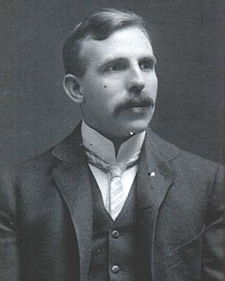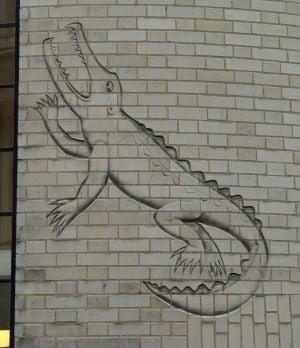Ernest Rutherford
|
Ernest Rutherford | |
|---|---|
 Ernest Rutherford, 1st Baron Rutherford of Nelson | |
| Born |
August 30 1871 |
| Died | October 19 1937 (aged 66) Cambridge, England |
| Residence | |
| Nationality | |
| Field | Physicist |
| Institutions | McGill University University of Manchester |
| Alma mater | University of Canterbury Cambridge University |
| Academic advisor | J. J. Thomson |
| Notable students | Mark Oliphant Patrick Blackett Hans Geiger Niels Bohr Cecil Powell |
| Known for | Being "the father" of nuclear physics |
| Notable prizes | |
| Note that he is the father-in-law of Ralph Fowler. Rutherford had a DSc (1900) from the University of New Zealand. | |
Ernest Rutherford, 1st Baron Rutherford of Nelson OM PC FRS (30 August 1871 - 19 October 1937), widely referred to as Lord Rutherford, was a nuclear physicist who became known as the "father" of nuclear physics. He pioneered the orbital theory of the atom through his discovery of Rutherford scattering off the nucleus with his gold foil experiment.
Early years
Ernest Rutherford was the son of James Rutherford, a farmer who had emigrated from Perth, Scotland, and his wife Martha (née Thompson), originally of Hornchurch, Essex, England.[1] His parents had moved to New Zealand 'to raise a little flax and a lot of children'. Ernest was born at Spring Grove (now Brightwater), near Nelson, New Zealand. His name was mistakenly spelt Earnest Rutherford when his birth was registered.[2] He studied at Havelock and then Nelson College and won a scholarship to study at Canterbury College, University of New Zealand where he was president of the debating society among other things. In 1895, after gaining his BA, MA and BSc, and doing two years of research at the forefront of electrical technology, Rutherford travelled to England for postgraduate study at the Cavendish Laboratory, University of Cambridge (1895-1898), and he briefly held the world record for the distance over which electromagnetic waves could be detected. During the investigation of radioactivity he coined the terms alpha and beta to describe the two distinct types of radiation emitted by thorium and uranium.
Middle years
In 1898 Rutherford was appointed to the chair of physics at McGill University in Montreal, Canada, where he did the work which gained him the 1908 Nobel Prize in Chemistry. From 1900 till 1903 he was joined by the young Frederick Soddy (Nobel Prize 1921) where they collaborated on research into the transmutation of elements. Ernest Rutherford had demonstrated that radioactivity was the spontaneous disintegration of atoms. He noticed that a sample of radioactive material invariably took the same amount of time for half the sample to decay — its "half-life" — and created a practical application for this phenomenon using this constant rate of decay as a clock, which could then be used to help determine the actual age of the Earth that turned out to be much older than most scientists at the time believed.
In 1907 Rutherford took the chair of physics at the University of Manchester. There he did the experiments along with Hans Geiger and Ernest Marsden (Geiger-Marsden experiment) that discovered the nuclear nature of atoms. It was his interpretation of this experiment that led him to the Rutherford model of the atom having a very small positively charged nucleus orbited by electrons. He became the first person to transmute one element into another when he converted nitrogen into oxygen. In 1921, while working with Niels Bohr (who postulated that electrons moved in specific orbits), Rutherford theorized about the existence of neutrons, which could somehow compensate for the repelling effect of the positive charges of protons by causing an attractive nuclear force and thus keeping the nuclei from breaking apart. Rutherford's theory of neutrons was later proved in 1932 by his associate James Chadwick who was awarded the Nobel prize in physics for his discovery in 1935.
Later years
He was knighted in 1914. In 1917 he returned to the Cavendish as Director. Under him, Nobel Prizes were awarded to Chadwick for discovering the neutron (in 1932), Cockcroft and Walton for splitting the atom using a particle accelerator and Appleton for demonstrating the existence of the ionosphere. He was admitted to the Order of Merit in 1925 and in 1931 was created Baron Rutherford of Nelson, of Cambridge in the County of Cambridge, a title which became extinct upon his unexpected death in hospital following a hernia operation.
Impact and legacy
His research, along with that of his protege, Sir Mark Oliphant was instrumental in the convening of the Manhattan Project to develop the first nuclear weapons. He is famously quoted as saying: "In science there is only physics; all the rest is stamp collecting." He is also reputed to have stated that the idea of using nuclear reaction to generate useful power was "moonshine"[3]
Named after Rutherford
- the element rutherfordium, Rf, Z=104. (1997) [4]
- craters on Mars and the Moon
- a building of the modern Cavendish Laboratory in the University of Cambridge, UK
- the Rutherford Institute for Innovation at the University of Cambridge, UK
- the physics and chemistry building at the University of Canterbury, New Zealand
- the Ernest Rutherford Physics Building at McGill University, Montreal, Canada
- Rutherford College, a school in Auckland, New Zealand
- a house at his own high school, Nelson College,
- a house at Corran School for Girls, Auckland, New Zealand
- a house at Rangiora High School, Rangiora, New Zealand
- a house at Macleans College, Auckland, New Zealand
- a house at Mount Roskill Grammar School, Auckland, New Zealand
- a house at Cashmere High School, Christchurch, New Zealand
- a house at Shirley Boys High School, Christchurch, New Zealand
- a house at St Andrews College, Christchurch, New Zealand
- a house at Island School, Hong Kong
- Rutherford College, a college at the University of Kent in Canterbury, UK
- a student hall at Loughborough University.
- a lecture theatre at the University of Manchester.
- Rutherford was the subject of a play by Stuart Hoar.
- Rochester and Rutherford Hall a boarding house at the University of Canterbury, Christchurch, New Zealand.
- Rutherford Appleton Laboratory a UK scientific research laboratory near Abingdon in Oxfordshire.
- Rutherford Close a residential street in Abingdon in Oxfordshire.
- a Physics classroom in the Portsmouth Grammar School
- Rutherford Road in biotech district of Carlsbad, CA, USA
On the side of the Mond Laboratory at the site of the original Cavendish Laboratory in Cambridge, there is an engraving in Rutherford's memory in the form of a crocodile, this being the nickname given to him by its commissioner, Rutherford's colleague Peter Kapitza. The initials of the engraver, Eric Gill, are visible within the mouth.
Rutherford's works
- Radio-activity (1904), 2nd ed. (1905), ISBN 978-1-60355-058-1
- Radioactive Transformations (1906), ISBN 978-160355-054-3
- Radiations from Radioactive Substances (1919)
- The Electrical Structure of Matter (1926)
- The Artificial Transmutation of the Elements (1933)
- The Newer Alchemy (1937)
See also
- Rutherford College, Auckland
- Rutherford Intermediate, Wanganui, New Zealand
ReferencesISBN links support NWE through referral fees
- ↑ An Encyclopaedia of New Zealand 1966, accessed 13 May 2007
- ↑ Campbell, John. 'Rutherford, Ernest 1871 - 1937'. Dictionary of New Zealand Biography, updated 22 June 2007
- ↑ Rutherford Quotes
- ↑ ACS Article on Rutherfordium
External links
- Nobel Lecture The Chemical Nature of the Alpha Particles from Radioactive Substances from Nobelprize.org website
- Biography Biography from Nobelprize.org website
- The Rutherford Museum
- Rutherford Scientist Supreme. For book email the publisher aas@canterbury.ac.nz
- "Ernest Rutherford 1871 - 1937". A Science Odyssey, pbs.org.
- http://www.nzedge.com/heroes/rutherford.html
- Annotated bibliography for Ernest Rutherford from the Alsos Digital Library for Nuclear Issues
- You can search for Ernest Rutherford @ http://www.dnzb.govt.nz
- Rutherford at Canterbury University College. The Rutherford Journal
- Rutherford's Timebomb: a New Zealand Herald article about Rutherford's contribution to dating the Age of the Earth
| Honorary Titles | ||
|---|---|---|
| Preceded by: Sir Charles Sherrington |
President of the Royal Society 1925 – 1930 |
Succeeded by: Sir Frederick Hopkins |
| Peerage of the United Kingdom
| ||
| Preceded by: New Creation |
Baron Rutherford of Nelson 1931-1937 |
Succeeded by: Extinct |
|
1901: Jacobus Henricus van 't Hoff | 1902: Hermann Emil Fischer | 1903: Svante Arrhenius | 1904: William Ramsay | 1905: Adolf von Baeyer | 1906: Henri Moissan | 1907: Eduard Buchner | 1908: Ernest Rutherford | 1909: Wilhelm Ostwald | 1910: Otto Wallach | 1911: Marie Curie | 1912: Victor Grignard, [Paul Sabatier | 1913: Alfred Werner | 1914: Theodore William Richards | 1915: Richard Willstätter | 1918: Fritz Haber | 1920: Walther Nernst | 1921: Frederick Soddy | 1922: Francis William Aston | 1923: Fritz Pregl | 1925: Richard Adolf Zsigmondy |
| Persondata | |
|---|---|
| NAME | Rutherford, Ernst |
| ALTERNATIVE NAMES | 1st Baron Rutherford of Nelson |
| SHORT DESCRIPTION | New Zealander nuclear physicist |
| DATE OF BIRTH | 30 August 1871 C.E. |
| PLACE OF BIRTH | Spring Grove, near Nelson, New Zealand |
| DATE OF DEATH | 19 October 1937 |
| PLACE OF DEATH | Cambridge, England |
Credits
New World Encyclopedia writers and editors rewrote and completed the Wikipedia article in accordance with New World Encyclopedia standards. This article abides by terms of the Creative Commons CC-by-sa 3.0 License (CC-by-sa), which may be used and disseminated with proper attribution. Credit is due under the terms of this license that can reference both the New World Encyclopedia contributors and the selfless volunteer contributors of the Wikimedia Foundation. To cite this article click here for a list of acceptable citing formats.The history of earlier contributions by wikipedians is accessible to researchers here:
The history of this article since it was imported to New World Encyclopedia:
Note: Some restrictions may apply to use of individual images which are separately licensed.


